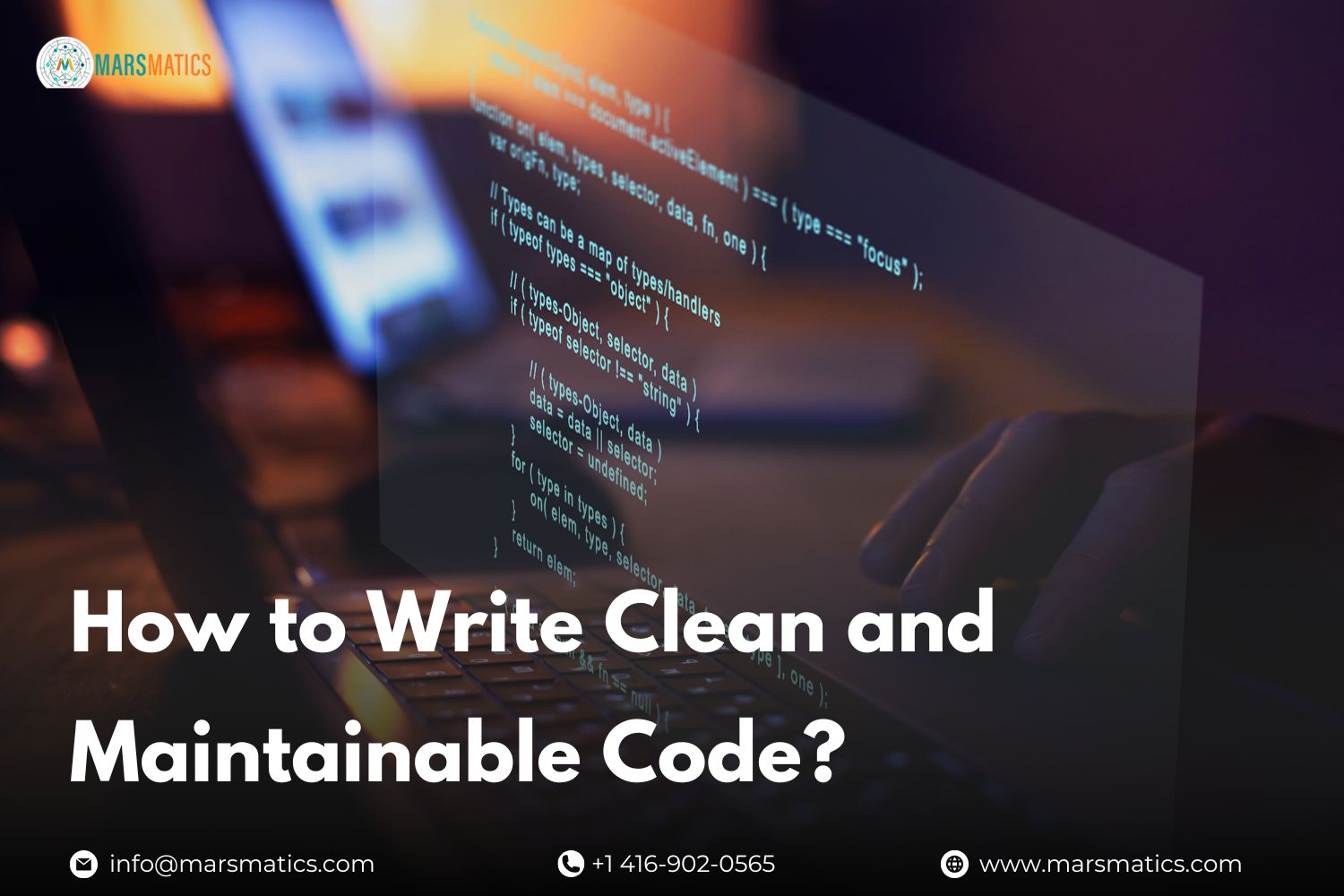How to Write Clean and Maintainable Code?
Suppose you open a piece of code you wrote six months ago, and it feels like reading someone else’s work or worse, a cryptic puzzle. Sound familiar? Writing code that’s functional is one thing, but crafting it so it’s easy to understand, update, and scale? That’s a whole other skill set.
How to write clean and maintainable code isn’t just about avoiding errors; it’s about building a foundation for long-term success. Clean code reduces bugs, saves time, and ensures that your work remains useful, even as projects evolve. In this blog, we’ll explore the best practices for clean code and share practical tips for writing maintainable code that developers will thank you for your future self included.
Why Clean and Maintainable Code Matters?
Clean and maintainable code isn’t just a nice-to-have—it’s a game-changer for developers and projects alike. Imagine working on a project where every line of code is easy to read, understand, and modify. It sounds like a dream, right? That’s exactly what clean code offers.
When you focus on how to write clean and maintainable code, you’re not just writing for the present—you’re writing for the future. Clean code ensures that your projects are scalable, easier to debug, and adaptable to changes. Whether it’s adding new features or fixing issues, maintainable code makes life easier for everyone involved.
On the flip side, messy code leads to frustration, delays, and higher costs. It’s one of the most common coding mistakes to avoid, as it can quickly turn even small updates into a daunting task. Clean code saves time, reduces errors, and fosters better collaboration within teams.
Key Principles of Writing Clean Code:
Mastering clean code principles is essential for building software that’s not just functional but also future-proof. Below, we break down the key pillars of writing maintainable code, with actionable insights and tips to avoid coding mistakes.
Readable and Understandable Code:
Readable code is code that doesn’t require a developer to play detective. It uses meaningful variable names, clear logic, and comments where necessary.
Do This:
Use descriptive names for variables and functions. Instead of x or temp, use userId or calculateTotal.
Example:
python
def calculate_discount(price, discount_rate):
return price * discount_rate
Avoid This:
Cryptic or overly compact code that sacrifices clarity for brevity.
Example: python def calc(p, d): return p*d
Readable code reduces misunderstandings and debugging time—one of the best practices for clean code.
Keep It Simple (KISS):
The KISS (Keep It Simple, Stupid) principle reminds us that simplicity is the ultimate sophistication. Over-engineering leads to complexity, making code harder to maintain.
Do This:
Break problems into smaller, straightforward solutions. Use tools and libraries only when necessary.
Example: Instead of writing a custom sorting algorithm, use built-in functions: python items.sort()
Avoid This:
Over-engineered code or unnecessary abstraction.
Example: Creating an elaborate function for basic sorting when one line would suffice.
KISS ensures developers focus on the task at hand without unnecessary distractions.
DRY (Don’t Repeat Yourself):
Repetition is the enemy of efficiency. The DRY principle emphasizes reusability by centralizing logic instead of duplicating it.
Do This:
Refactor repetitive code into reusable functions or classes.
Example:
python
def calculate_tax(amount, rate):
return amount * rate
federal_tax = calculate_tax(1000, 0.05)
state_tax = calculate_tax(1000, 0.02)
Avoid This:
Copy-pasting the same logic across multiple places. It increases the risk of errors when updates are needed.
Example: python federal_tax = 1000 * 0.05 state_tax = 1000 * 0.02
By avoiding repetition, you improve efficiency and ensure easier updates.
Consistent Coding Style:
Consistency is crucial when multiple developers collaborate. A consistent style ensures readability and reduces misunderstandings.
Do This:
Follow a style guide (e.g., PEP 8 for Python, Airbnb for JavaScript). Use tools like ESLint or Prettier to enforce consistent formatting.
Avoid This:
Mixing tabs and spaces or using inconsistent naming conventions like getData() in one place and fetch_data() elsewhere.
Consistency is a hallmark of clean code principles and boosts collaboration.
Small Functions and Single Responsibility Principle:
Each function should do one thing and do it well. Functions with multiple responsibilities are harder to test, debug, and reuse.
Do This:
Break functions into smaller, focused tasks.
Example:
python
def fetch_user_data(user_id):
# Fetch data from database
pass
def validate_user_data(user_data):
# Validate user information
pass
Avoid This:
Functions that handle multiple unrelated tasks.
Example:
python
def process_user(user_id):
# Fetch, validate, and process all in one
pass
This principle ties directly into writing maintainable code by ensuring your codebase is modular and scalable.
Tools and Techniques to Improve Code Quality:
Improving code quality is essential for delivering robust and scalable software. By utilizing the right tools and adopting proven techniques, you can ensure that your code adheres to clean code principles and remains easy to work with. Here’s a breakdown of effective methods to help with writing maintainable code while avoiding common coding mistakes to avoid.
Also Read: The Importance of Code Refactoring in Software Development
Code Linters and Formatters:
Linters and formatters automatically analyze and tidy up your code, ensuring it’s clean, consistent, and error-free.
How They Help:
- Identify syntax errors, unused variables, and potential bugs.
- Enforce consistent formatting across your codebase.
Popular Tools:
- ESLint (JavaScript/TypeScript): Enforces coding standards and catches issues early.
- Prettier: Formats code consistently based on predefined rules.
- Pylint (Python): Checks for coding errors and enforces PEP 8 guidelines.
Why It Matters:
Using linters and formatters is one of the best practices for clean code. They help you focus on logic and functionality instead of formatting issues.
Version Control Systems:
Version control systems (VCS) like Git are indispensable for modern development.
How They Help:
- Track every change made to the codebase, making it easy to revert mistakes.
- Facilitate collaboration among team members.
- Allow branching and merging to manage different versions of the code.
Popular Tools:
- Git: Paired with platforms like GitHub, GitLab, or Bitbucket, Git is the industry standard for version control.
Why It Matters:
Without a VCS, managing changes becomes chaotic, leading to more coding mistakes to avoid, such as overwriting someone else’s work or losing track of changes.
Unit Testing and Test-Driven Development (TDD):
Testing is crucial to ensure your code works as intended, and TDD takes it one step further by writing tests before the actual implementation.
How They Help:
- Catch bugs early by validating individual components.
- Ensure code changes don’t break existing functionality.
Key Concepts:
- Unit Testing: Tests small, isolated parts of your code (e.g., functions or methods).
- TDD: Write tests first, then develop the code to pass those tests.
Popular Tools:
- JUnit (Java), PyTest (Python), Jest (JavaScript).
Why It Matters:
Testing is integral to writing maintainable code. By integrating unit tests into your workflow, you minimize the risk of introducing bugs, improving overall quality.
Code Reviews:
Code reviews involve having peers examine your code before it’s merged into the main branch.
How They Help:
- Identify potential issues that automated tools may miss.
- Improve code readability and maintainability.
- Foster knowledge sharing among team members.
Best Practices for Code Reviews:
- Focus on the logic and structure, not just syntax.
- Provide constructive feedback and encourage discussion.
Why It Matters:
Code reviews reinforce clean code principles by ensuring that every line of code aligns with quality standards. They also serve as a checkpoint to prevent coding mistakes to avoid before deployment.
Best Practices for Long-Term Code Maintainability:
- Prioritize readability, simplicity, and logical structure to ensure future developers can easily understand and modify the code.
- Provide clear comments and maintain up-to-date documentation to explain complex logic and system design.
- Use a style guide and automated tools like linters to enforce uniformity across the codebase.
- Break code into small, single-responsibility functions or components for easier updates and testing.
- Regularly test your code to catch bugs early and ensure changes don’t break existing functionality.
- Leverage tools like Git for tracking changes and managing collaboration efficiently.
Revisit and improve old code to keep it clean and optimized as your project evolves.
Encourage peer reviews to maintain high-quality standards and share knowledge among the team.
Common Mistakes to Avoid:
- Lack of documentation makes code harder to understand and maintain.
- Adding unnecessary complexity leads to difficult-to-maintain code.
- Mixing styles or conventions creates confusion and reduces readability.
- Failing to write unit tests increases the risk of bugs and regressions.
- Embedding constants in code makes updates cumbersome and error-prone.
- Allowing messy code to grow without cleanup creates technical debt.
- Lack of version control makes collaboration and tracking changes chaotic.
- Duplicating logic increases maintenance effort and risk of errors.
Also Read: Cracking the Code: How Marsmatics Fixes Bad Code
Conclusion:
Using clean code principles and following best practices for clean code are key to writing maintainable code that lasts. By keeping your code simple, readable, and organized, it becomes easier to understand and update over time. Avoiding coding mistakes to avoid, like unnecessary complexity or skipping tests, helps you create better, more reliable code. Stick to these principles, and your future projects will be much smoother and easier to work with.








